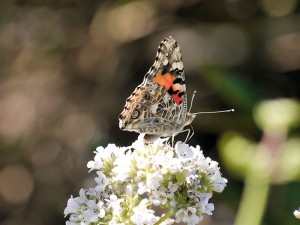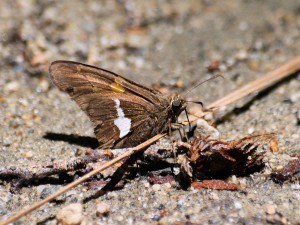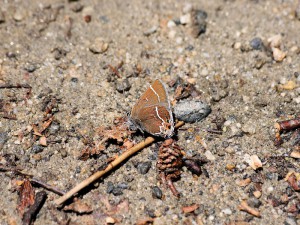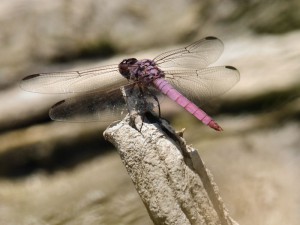The old saying goes “Close only counts in horseshoes and hand grenades.” But we who study butterflies, dragonflies, or other small creatures, know that many other things need proximity. Getting close looks at and/or photographing them requires optics that let you see these beauties in enough detail. That means being able to focus at very short distances. On the Optics4Birding website, a binocular’s close focus distance must be less than 8 feet to be considered close-focusing. I photographed these butterflies with a lens that allows close focus as well. All these images are full frame. I have not cropped the photos, only resized them to fit our page format. The Painted Lady (above) was feeding on nectar from these flowers.
The Silver-spotted Skipper (left) and Juniper Hairstreak (right) both liked wet sand we made by taking water from a stream a few feet away. They seem to prefer wet sand in the sun rather than in the shade by the stream. Popular binoculars that will help you with getting close are Zeiss Terra 42mm Binoculars (5.25′), Kowa BD42 II XD Binoculars (4.9′), Meopta MeoPro HD Binoculars (4.9′), Vortex Viper 42mm (5′), Kowa Genesis 33mm Binoculars (4.9′), Vortex Razor 42mm Binoculars (6′), Swarovski NL Pure Binoculars (6.6′), and Zeiss Victory SF 42mm Binoculars (4.9′).
Getting Close with Spotting Scopes
Sometimes, there are other obstacles to getting close. Fences and bodies of water can keep you too far away to take advantage of close-focusing cameras or binoculars. Occasionally, getting close as you would like will spook the animal. Enter spotting scopes and digiscoping. The Roseate Skimmer seen here was 20 feet away on the other side of a fence and some mud. The photograph was taken with a micro 4/3 camera, its zoom lens set to 84mm (42mm times 2x crop factor), and the TE-11WZ 25-60x zoom eyepiece on a Kowa TSN-884 spotting scope set at 25x for an equivalent focal length of 2100mm.




